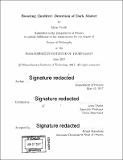| dc.contributor.advisor | Jesse Thaler. | en_US |
| dc.contributor.author | Necib, Lina | en_US |
| dc.contributor.other | Massachusetts Institute of Technology. Department of Physics. | en_US |
| dc.date.accessioned | 2017-10-30T15:30:19Z | |
| dc.date.available | 2017-10-30T15:30:19Z | |
| dc.date.copyright | 2017 | en_US |
| dc.date.issued | 2017 | en_US |
| dc.identifier.uri | http://hdl.handle.net/1721.1/112073 | |
| dc.description | Thesis: Ph. D., Massachusetts Institute of Technology, Department of Physics, 2017. | en_US |
| dc.description | Cataloged from PDF version of thesis. | en_US |
| dc.description | Includes bibliographical references (pages 153-178). | en_US |
| dc.description.abstract | In this thesis, I study the expected direct and indirect detection signals of dark matter. More precisely, I study three aspects of dark matter; I use hydrodynamic simulations to extract properties of weakly interacting dark matter that are relevant for both direct and indirect detection signals, and construct viable dark matter models with interesting experimental signatures. First, I analyze the full scale Illustris simulation, and find that Galactic indirect detection signals are expected to be largely symmetric, while extragalactic signals are not, due to recent mergers and the presence of substructure. Second, through the study of the high resolution Milky Way simulation Eris, I find that metal-poor halo stars can be used as tracers for the dark matter velocity distribution. I use the Sloan Digital Sky Survey to obtain the first empirical velocity distribution of dark matter, which weakens the expected direct detection limits by up to an order of magnitude at masses </~ 10 GeV. Finally, I expand the weakly interacting dark matter paradigm by proposing a new dark matter model called boosted dark matter. This novel scenario contains a relativistic component with interesting hybrid direct and indirect detection signatures at neutrino experiments. I propose two search strategies for boosted dark matter, at Cherenkov-based experiments and future liquid-argon neutrino detectors. | en_US |
| dc.description.statementofresponsibility | by Lina Necib. | en_US |
| dc.format.extent | 178 pages | en_US |
| dc.language.iso | eng | en_US |
| dc.publisher | Massachusetts Institute of Technology | en_US |
| dc.rights | MIT theses are protected by copyright. They may be viewed, downloaded, or printed from this source but further reproduction or distribution in any format is prohibited without written permission. | en_US |
| dc.rights.uri | http://dspace.mit.edu/handle/1721.1/7582 | en_US |
| dc.subject | Physics. | en_US |
| dc.title | Boosting (in)direct detection of dark matter | en_US |
| dc.type | Thesis | en_US |
| dc.description.degree | Ph. D. | en_US |
| dc.contributor.department | Massachusetts Institute of Technology. Department of Physics | |
| dc.identifier.oclc | 1006748388 | en_US |
